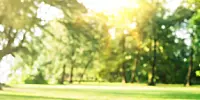-
Warm days ahead: French weekly weather outlook March 31 - April 4
Temperatures of 20C are expected towards the end of the week across France
-
What you should do to your garden in France in spring
Weeding, pruning, sowing, preparing the lawn…here is how to welcome sunnier days
-
Rain, wind, snow, sun: French weekend weather outlook March 29 - 30
Cooler temperatures are in store before warm spell at the start of next week
Budburst season gives clues for year ahead
Sometime from late March to mid-April the vines begin their annual growth.

The moment when the young green shoots appear from the buds is known as budburst, débourrement in French. It is a pretty important moment in the vineyard
First of all, it gives a rough estimation of when harvest will take place. Each variety (cépage) of grapevine requires a certain number of heat degree-days (HDD) to ripen. The HDD is the sum of the average daily temperatures over 10°C. So we can use the date of budburst and the average daily, or monthly temperature to predict harvest date. Budburst is affected by soil temperature, so a warm end to winter will give an early budburst and a cold-spell will make it later. Different varieties also have different budbursts eg: Chardonnay buds almost a month before Riesling in the same climate.
Initially shoot growth is pretty slow, especially if the vine is lacking in nutrients. Within a few weeks the future bunches, known as inflorescences, become visible. These inflorescences were in fact formed within the bud in the previous summer. The number and size of the bunches is therefore pre-programmed. However, it is not constant from year to year. So observing the number and size of these inflorescences will tell the vigneron the likely volume of his harvest, at least in terms of numbers of bunches. Each shoot will have from zero to three inflorescences. The number actually depends on the warmth and dryness of the previous season at flowering. So a cold, wet early summer can mean a small harvest the following year.
These baby shoots are fragile. It is during this period that frost can mean disaster. The young green shoot can freeze and die. That is why you may see vignerons burning little stoves (often from the prunings) in between their vines. More modern methods of frost-protection include the use of helicopters and water sprays. Helicopters move the freezing air and water sprays coat the shoot in a thin layer of ice, which stays at 0°C, protecting the shoot from sub-zero air. (I know, it sounds crazy, but it works.)
Here in the south of France we have strong, wild winds like the Tramontane and the Mistral and sometimes they can snap off the baby shoots. So it is best not to count your shoots until they are hatched, so to speak.
The young shoots are also susceptible to powdery mildew, known as oidium in France, so you will often see vignerons spraying liquid sulphur or dusting them with the yellow sulphur powder. It’s a pretty unpleasant job because it stings your eyes and chokes you. Sulphur is an organic fungicide in case anyone was under the misconception that organic vignerons do not spray fungicides. Sulphur powder or spray has nothing to do with sulphites in wine though.
Certain varieties, notably Carignan, are much more susceptible than others to this early-season oidium. If left untreated the young shoots will become covered in the grey powder-like fungus and either die or make flag-shoots, where all the leaves except the newest one rot and fall off.
Shortly afterwards, the first tendrils will appear, looking for something to wrap around to help the shoot climb upwards. At this time the shoot grows more rapidly at around 2-3cm per day.
Once the young shoots reach about 30cm, they start to lignify and toughen up against the wind, frost and oidium. Vines on trellis can now have the wires raised to encourage vertical growth of the stems by providing something for the tendrils to cling onto. Slow and stunted growth during this period is a sign of malnutrition, notably nitrogen compounds. Similarly, overly-bushy growth is a sign of soils that are too rich or over-fertilised.
Once again, by observing the growth of the vine, an experienced eye can tell whether the vineyard is likely to produce a good crop of evenly ripened grapes or whether the effects of soil nutrients, vine health or the variance of the vintage are going to lead to a poor harvest. The signs of whether it will be a good year are already there. But summer can change all that.
. Jonathan Hesford studied oenology and viticulture in New Zealand and is the winemaker and owner of Domaine Treloar in the Roussillon. www.domainetreloar.com
A year in the vineyard with Jonathan Hesford of Domaine Treloar
The Terroirist
























